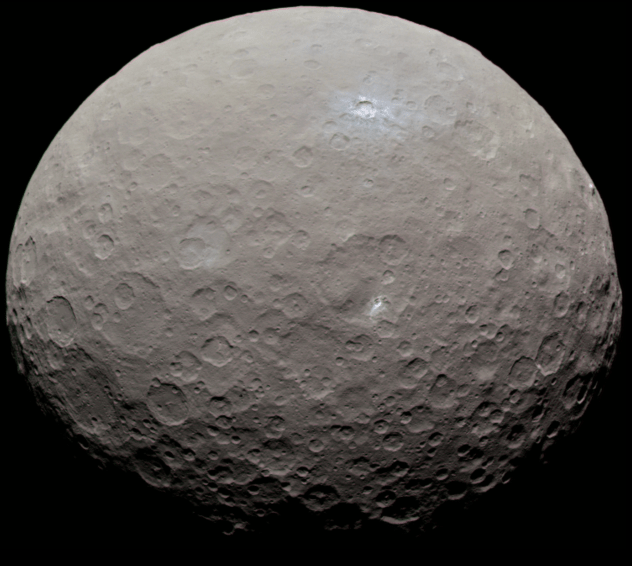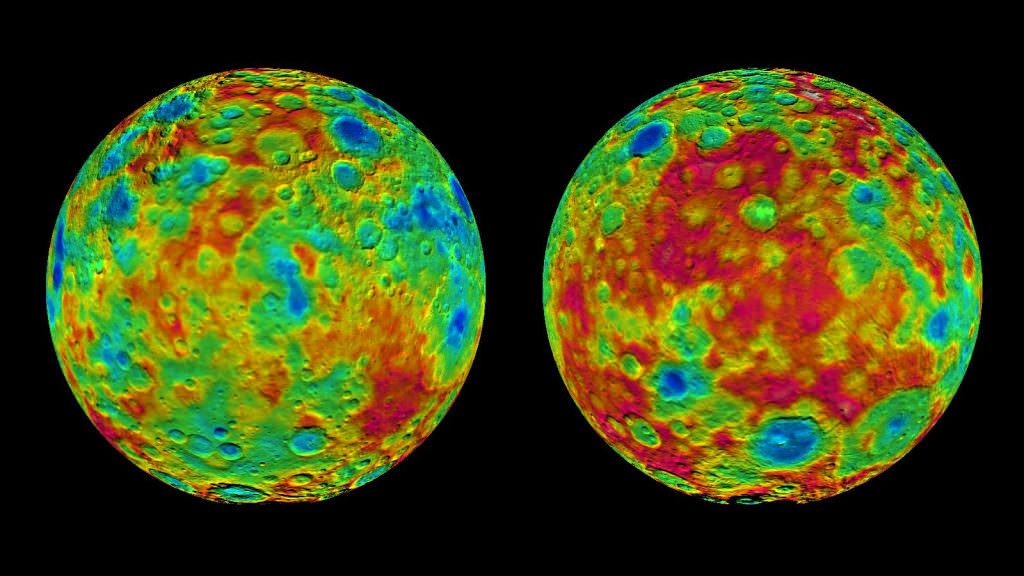Welcome back to our series on Settling the Solar System! Today, we take a look at the largest asteroid/planetoid in the Main Belt – Ceres!
Between the orbits of Mars and Jupiter lies the Solar System’s Main Asteroid Belt. Within this region, it is estimated that there are over 150 million objects that measure 100 meters (330 ft) or more in diameter. The largest of these is the dwarf planet Ceres (aka. 1 Ceres), the only body in the Main Belt that is large enough – 940 km (585 mi) in diameter – to have undergone hydrostatic equilibrium (become spherical).
Because of its important location and the amenities this dwarf planet itself possesses, there are those who have proposed that we establish a colony on Ceres (and even some who’ve explored the idea of terraforming it). This could serve as a base for asteroid mining ventures as well as an outpost of human civilization, one which could facilitate the expansion of humanity farther out into the Solar System.
But could a colony really exist on Ceres’ icy surface, and what would it take to create and maintain such a settlement?

Examples in Fiction:
For almost a ce
In The Stars My Destination (1956) by Alfred Bester, the main character claims to be from Ceres. Ceres is also a recurring location in the works of Robert A. Heinlein, receiving passing mentions in Red Planet (1949), Time for the Stars (1950), The Rolling Stones (1952), Podkayne of Mars (1963), and The Cat Who Walks Through Walls (1985).
In Joe Haldeman’s novel Buying Time (1989), Ceres is the home of a society of anarchists and where the wealthy go to seek rejuvenation treatments to cheat death. Larry Niven also has Ceres as the seat of a government that rules the Asteroid Belt in novels and short stories that take place in his Known Space universe (1964 to the present).
In L. Neil Smith’s novel The Venus Belt (1981), Ceres contains a large underground city that is interconnected by several smaller settlements and stations. It is also the focal point of his 2009 novel, Ceres.
Bruce Sterling’s novel Schismatrix (1985) also features an Asteroid Belt colonized by cybernetically-enhanced humans, whose communications are handled by a corporate-national entity based on Ceres. In Marooned in Realtime (1986) by Vernor Vinge, one of the characters earned a doctorate in Mayan archaeology from the “Universidad Polytecnica de Ceres.”
In Leviathan Wakes and other books in The Expanse series written by Daniel Abraham and Ty Franck (pen name James Corey), Ceres is the location of a major colony. It is here where mining operations in the Main Asteroid Belt (conducted by “Belters”) are largely coordinated. The colony is located beneath the surface in a series of tunnels while a sped-up rotation provides artificial gravity equal to about 0.3 g.
Possible Methods:
Colonizing Ceres would involve many of the same methods used to establish colonies on the Moon, Mercury, and the satellites of Jupiter and Saturn. Basically, it comes down to establishing settlements that are optimized for bodies that have little to no atmosphere and are subject to extreme temperatures – i.e. pressurized, air-tight, and heavily insulated.
These could be established within impact craters that could then be sealed with the attachment of a dome. Regolith mined from the asteroid belt could then be used to 3D print a base layer next to the ice, and then print out structures. Ice and organic molecules could be harvested locally to provide water and nutrients which, when combined with regolith, would provide the necessary soil for growing food.
Alternately, a colony could be established within the planet’s icy crust. This would be most beneficial if engineers were to attempt to speed up Ceres’ rotation (though this represents a major challenge in its own right). With the colonies’ vertical axis aimed towards the center of Ceres, this rotation would generate centrifugal force that would provide artificial gravity.
With the local availability of water ice, minerals, silica, and other raw materials, a degree of self-sufficiency could be achieved with time.
Potential Benefits:
As already noted, the fact that Ceres is the largest body in the asteroid belt makes it a good location for a potential colony. This could act as the main base and transportation hub for asteroid mining, which would allow for resources extracted from the Belt to be transported back to Mars and/or Earth. It could also be a stopover and resupply/refueling point for missions bound for the outer Solar System.
Because of its low gravity, Ceres also has a very low escape velocity of 0.51 km/s (~0.32 mi/s). This means that much less propellant and energy would be needed to launch spacecraft from its surface than with other bodies in the Solar System. Transportation to and from Ceres with other planets would, therefore, be much cheaper and more energy-efficient.
Ceres’ rich resource base also makes it an appealing piece of real estate. The availability of water ice, for example, means that a colony could be largely self-sustaining, with colonists able to provide for their own oxygen gas as well as drinking water and irrigation. The presence of methane and ammonia could also be used to manufacture fuel, nitrogen gas, or be exported to help terraform planets like Mars and Venus.
The presence of these resources also means that a colony could be constructed using resources harvest on-site – aka. In-Situ Resource Utilization (ISRU). Resources sourced from Ceres and the surrounding Belt would also mean that the colony would not need them to be shipped from Earth and/or other locations outside the Belt.

Challenges:
While it is the largest body in the Main Asteroid Belt, Ceres is considerably smaller and less massive than most objects in the Solar System. With its diameter of 940 km (585 mi), Ceres is about half as large as the Moon. But since Ceres is largely composed of water ice and less dense materials, it is only about 1% as massive (0.0128 times that of the Moon).
This results in a very low surface gravity of 0.029 g, or roughly 3% that of Earth. In other words, people living on the surface of Ceres would be in a state of near-weightlessness the entire time they were there. Hence, they would experience physiological effects very similar to what astronauts go through during long-term stays aboard the International Space Station (ISS).
These include muscle-loss, bone density-loss, diminished eyesight, diminished organ function, cardiovascular issues, and even psychological effects. For this reason, medical treatments or some form of artificial gravity (centrifuges or increased rotation, for example) would be necessary to ensure that colonists don’t have to limit their time on Ceres. These measures would also need to address what effects low-g would have on reproduction.
And of course, there is the sheer expense that colonizing this body would entail. While the necessary resources could be harvested on-site, vessels that are capable of long-duration missions to deep space would be needed before any missions could be contemplated. This would probably entail nuclear-thermal or nuclear-electric propulsion (NTP/NEP) concepts, or possibly something more advanced.

It is also likely that any attempts to establish a permanent base in the Main Asteroid Belt would have to wait for infrastructure to first be built on the Moon, Mars, and everywhere in between. Any attempts to colonize the Main Asteroid Belt would otherwise be prohibitively expensive and would likely collapse before future missions could reach it and resupply it.
But with time and the establishment of colonies closer to Earth, a colony on Ceres would be the next logical step. Not only would it open up the Main Asteroid Belt for economic exploitation; it would also serve as a stepping stone to the outer Solar System, which could lead to the creation of colonies on Jupiter’s moons and beyond.
We have written many articles about colonizing the Solar System here at Universe Today. Here’s How Do We Colonize the Moon?, How Do We Colonize Mars?, How Do We Colonize Venus?, How Do We Colonize Mercury?, How Do We Colonize on Jupiter’s Moons?, and How Do We Colonize Saturn’s Moons?
For more information, check out the colonization series by Fraser Cain featuring Youtube sensation Isaac Arthur – Colonizing the Inner Solar System, and Colonizing the Outer Solar System.
Sources:

